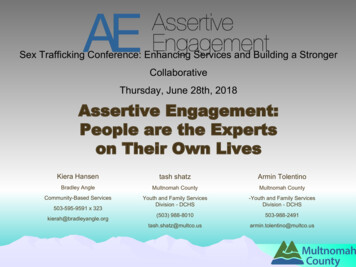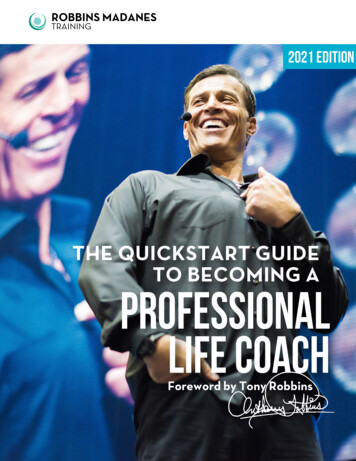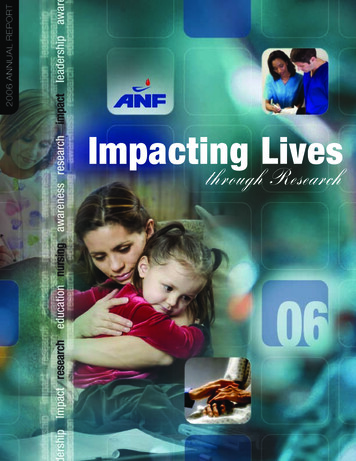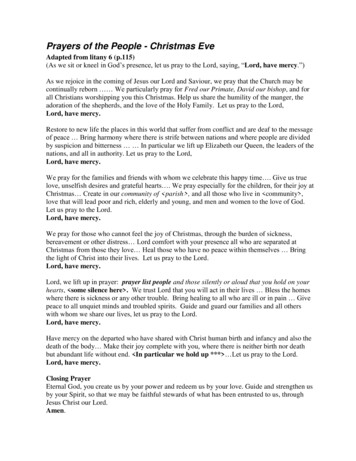
Transcription
Sex Trafficking Conference: Enhancing Services and Building a StrongerCollaborativeThursday, June 28th, 2018Assertive Engagement:People are the Expertson Their Own LivesKiera Hansentash shatzArmin TolentinoBradley AngleMultnomah CountyMultnomah CountyCommunity-Based ServicesYouth and Family ServicesDivision - DCHS-Youth and Family ServicesDivision - DCHS(503) ntino@multco.us503-595-9591 x 323kierah@bradleyangle.org
Goals: we’re here to. explain Assertive Engagement research and frameworks practice Motivational Interviewing techniques includingactive listening, giving reflections, and more offer space to consider how Assertive Engagement fits intoyour work
Objectives: after training,participants will be able to. more effectively use active listening, reflections, and othertools to support the people you work with more easily identify the expertise of those you work withand maintain empathy for them more clearly recognize and challenge judgements ineveryday interactions
Challenge CirclesChallenge ZoneComfort ZoneDangerZone!!!!REAL IS BETTERTHAN PERFECT
Guidelines for learning Be willing to grapple with challenging ideas. Hold your opinions lightly and withhumility. Notice your own defensive reactions and attempt to use these reactions asentry points for gaining deeper self-knowledge, rather than as a reason forclosing off. Recognize how your own social positions (like race, class, gender, sexuality,ability) inform your perspectives and reactions. Notice the difference between safety and comfort. Accept discomfort asnecessary for growth. Identify where your learning edge is and push it. For example, whenever youthink, I already know this, ask yourself, How can I take this deeper? Or, Howam I applying in practice what I already know?These guidelines are adapted from:“Respect Differences? Challenging the Common Guidelines in Social Justice Education,”by Özlem Sensoy and Robin DiAngelo, published in Democracy and Education.
Definition from training by Sarah Nedeau
What is AssertiveEngagement?“I believe that Assertive Engagement is more working withthe people (clients), not for the people. It's guiding clientsovercoming challenges that they see as a barriers to theirsuccess. It's more of letting clients decide their pathwaysand guide them.”“We empathize with clients situation and try to create a safeand positive environment for them. We welcome diversity.We engage with clients who often are looking for help - offerresources and answer questions they may have.”Quotes from recent cohort of service providers
What is AssertiveEngagement?Assertive Engagement weaves three evidence basedpractices together with the processes and outcomesassociated with your program to make a cohesive model Strengths Based Practice Motivational Interviewing Assertive Outreach (ACT) The processes and outcomes ofyour program
Three “Sets” of AEMind Set How we think about the people wework withSkill Set How we do our workHeart Set How we feel about and how we treat thepeople we work with
EquityandmSkill Set-Adjusting ourskills to beculturallyresponsiveMindSet--EmpathyHeart SetApproachingpeople u--Addressing ourown biases andjudgementsUnderstandingour own traumaa
Brainstorming Barriers
What is empathy?Brené Brown on Empathy RSA Short video:https://www.youtube.com/watch?v 1Evwgu369Jw
Our definition of empathy:empathy is understanding someone'sperspective and letting them know youunderstand
Skill Set Howwe do our workListening Activitytalk for 3 minutes about whether you prefercats, dogs, or neither and why
“How” is more important than “what”Skill Set Behave like you have all day and it will take 15 minutes,behave like you have 15 minutes and it will take all day Reflections are key for demonstrating empathy– Words – say back a few of the words they used– Meaning – restate their meaning with different words– Emotion – state what they are feeling Our desire to give advice is much higher than otherpeople’s desire to hear itMiller, W.R, & Rollnick, S. (2013). Motivational interviewing: Helping people change. New York: Guilford press.
Mind Set How wethink about thepeople we work withHow to give informationASK - OFFER - ASK1.2.3.4.Ask what they already knowAsk permission to provide new informationOffer the informationAsk what they think
“How” is more important than “what”Mind Set Focus on capacity, strength, and opportunityrather than on problems, failures, and obstacles People are the experts on their own experience People know what they need or want to change;and arguments for change must come fromthem, not us
Heart Set How wefeel about and howwe treat the peoplewe work withActivity: What difference dointerventions make?Miller, William. "Rediscovering Fire: Small Interventions, LargeEffects." Psychology of Addictive Behaviors. 14. no. 1 (2000): 6-18.
What Works? Common Factors Theorysuggests that only 15% ofclient success is attributableto the model used. 85% of factors identified forsuccessful treatment comefrom client factors, hope orbelief in change, and therelationship between theprovider and clientDuncan, B., Miller, S., Wampold, B., & Hubble, M. 2nd Edition (2009) The Heart and Soul of Change: What Works in Therapy.Washington, DC: American Psychological Association
“How” is more important than “what”Heart Set Hierarchy is critical, how are we sharing power? Change is difficult It’s about hope Persistence – don’t give up Creativity – try something different The most powerful resource we have is us
Closing
Bibliography Miller, W.R, & Rollnick, S. (2013). Motivational interviewing: Helping people change. New York:Guilford press.Center for Evidenced Based Practices, "ACT: Making the Case.” Accessed September s/pdf/actoverview.pdfClark, Michael. Center for Strengths-Based Strategies, "Great Lakes Training Inc." Accessed May11, 2012. http://www.buildmotivation.com/.Gladwell, Malcolm, (2005) Blink: The Power of Thinking Without Thinking, Little, Brown, andCompany.Mid-Atlantic Addiction Technology Technology Center, "Motivational Interviewing." Last modified2011. Accessed May 11, 2012. http://www.motivationalinterview.net/.Miller, William. "Rediscovering Fire: Small Interventions, Large Effects." Psychology of AddictiveBehaviors. 14. no. 1 (2000): 6-18.Duncan, B., Miller, S., Wampold, B., & Hubble, M. 2nd Edition (2009) The Heart and Soul ofChange: What Works in Therapy. Washington, DC: American Psychological Association.Rollnick, Stephen Ph.D., (2013) The Updated Motivational Interviewing – Evidence-based Skills toMotivate Clients Toward Change.Family Independence Initiative, http://www.fii.org/Brené Brown on Empathy RSA Short video: https://www.youtube.com/watch?v 1Evwgu369JwThe Effective/Ineffective Physician videos were produced by University of Florida Department ofPsychiatry. Funded by Flight Attendant Medical Research Institute Grant #63504Eleanor Longden “The Voices in My Head” TED talk:https://www.youtube.com/watch?v syjEN3peCJwAE training for Multnomah County was originally led by Seth Lyon, LCSWwith Kenan Ginsberg, LSSW.
explain Assertive Engagement research and frameworks practice Motivational Interviewing techniques including active listening, giving reflections, and more . Funded by Flight Attendant Medical Research Institute Grant #63504 Eleanor Longden "The Voices in My Head" TED talk:











